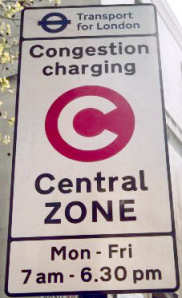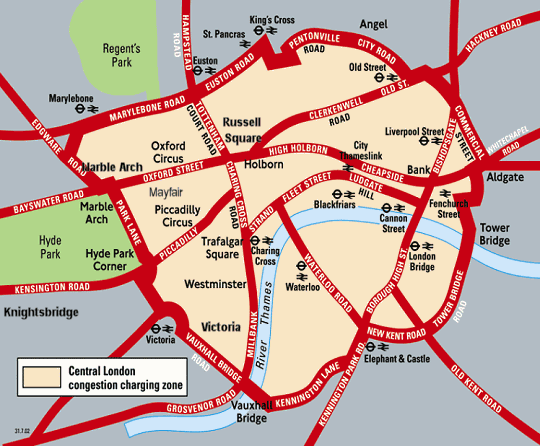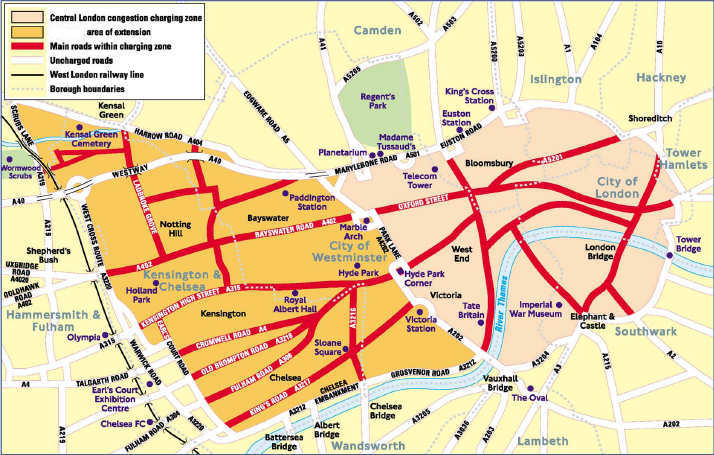On Monday, February 17th 2003 a congestion charge, (known locally as the Kengestion charge after the man who brought it in, Ken Livingston London Mayor), was introduced into the central areas of London. Based on a system of cameras that photographs and then registers you car licence plate number in its database. These cameras are located at all entry points into the London congestion charge zone and within the zone itself and actually photograph both front and rear plates on entry and exit of the zones. There also some mobile units that can take pictures anywhere within the zone. The cost of setting up the scheme was £200 million pounds and the cost of running the scheme is around £115 million pounds a year. In its first two years the scheme made £70 million pounds and £97 million pounds in 2004/2005.
Congestion in the zone has fallen by 30% while the volume of traffic within the zone is down by 15%. 30% of business's within the zone reported a drop in trade although 22% noted an increase. However motorists continue to complain of being wrongly fined having paid the charge or not even having been in the zone at the time the system registered the number plate. The current system of cameras works on analogue technology and accuracy is not 100% and can be affected by things such as the weather. The system has also seen an increase in the number of cloned licence plates. This is a situation where a driver will copy the plates of a similar vehicle. This is the stumbling block of a static traffic control system such as cameras as compared to the mobile use of police. If someone uses your plate its up to you to prove there weren't used by you at that time and place.
For many years the idea of charging motorists for entering into cities, driving on congested motorways or simply driving at certain times of the day had been touted by politicians. Normally their argument for this is two fold. Firstly it can be seen a green tax on motorists, charging them for adding to the levels of pollution and the damage they do to the environment. Secondly raising extra revenue from motorists means this money can be re-invested into the public transport system giving an improved public transport system and increased incentives for the public to switch to these systems further reducing overall levels of traffic. It wasn't until Ken Livingston become London Mayor of London that the idea was taking from theory into practice. The Tony Blair led New Labour party setup the institution of London Mayor in such a way that allowed the mayor to revenue by this means. Ken Livingston himself was always anti-car and pro-public transport and in terms of the UK's first true major road pricing scheme it became a match made in heaven.
Who Pays?
Not all motorists pay the congestion charge. Disabled drivers with a blue badge can qualify for up to a 100% discount, residents within the congestion zone can register one vehicle for a 90% discount, alternative fuel vehicles that meet the emissions criteria can claim a discount of up to 100%, buses and coaches with 9 or more seats which are licensed as a bus or reduced emissions vehicle can claim full discount, recovery vehicles, accredited breakdown vehicles, licensed London taxis, emergency vehicles, motorbikes and electric vehicles get full discount.
Cost
Just before the scheme went into full operation Ken Livingstone help consultations and polls on how much the charge should be. He was personally in favour of a £10 charge but it was finally brought it at £5. On the 5th July 2005 was the charge was raised to £8. Until mid 2006 you had to pay the charge by 10pm on the day you entered the controlled zone. However since mid 2006 you now have until midnight to pay the charge at the same rate or until midnight the day following entering the zone at a small increased charge which is currently £14. The normal congestion charge when paid on the same day as you enter the zone is currently £11.50.
A new option brought in 2011 is the auto charge. This means once you have registered for the scheme your credit/debit card is automatically charged each time you use the congestion zone (one time per chargeable day). The benefit is two fold, you will never pay the increased charge for late payment and the congestion charge itself is discounted so you pay currently just £10.50 per day when using auitopay.
Failure to pay by midnight the day after entering the zone means the issuing of a £130 fine. The fine is reduced to £65 if paid within 14 days. If the fine is unpaid after 28 days it is raised to £195.
Vehicles with three or more outstanding fines may be clamped or removed. The current clamp fee is £65 and the removal fee is £150. Storage in the car pound also costs £25 a day. If a vehicle is clamped or removed, then all of the outstanding penalty charges and the appropriate clamp/removal and storage fees must be paid before the release of the vehicle is authorised. If the release fee is not paid, then the vehicle may be disposed at auction or by scrapping. The registered keeper will remain liable for all outstanding charges, including a £60 disposal fee.
recap: congestion charge is £11.50 per day or £14 by midnight the day following entering the zone. CC Auto Pay charge is £10.50 per day.
Hours of Operation
The scheme does NOT operate 24/7. The hours you will be charged from are:
7.00 am until 6.00 pm Monday till Friday.
Exemption days are weekends, Bank Holidays and the first three normal charging days that follow the 26th December.
Payment
Payment can be made in advance of travelling in the London congestion zone or up to 10 pm on the day of having been within the charging zone zone with no penalty.
Online: log onto the www.cclondon.com website to enter your details and pay the charge.
Text from mobile phone: First you need to register with cclondon to use this service. Having registered send a text message to 81099 with the last four digits of your credit or debit card. You will be sent a confirmation message back to your mobile phone acknowledging charge payment for the vehicle you have registered.
Selected shops, petrol stations and car parks: You can pay at any of these location and self service machines where they are displaying the congestion logo:
Retail outlets with these facilities are nationwide and not just in London.
Telephone: call this number to pay: 0845 900 1234
Fast track card: Registering for this service will allow you to use the touchpad of your normal telephone to enter a pin which will recognise all your details speeding up the payment process.
pay online here >>>London Congestion Website
Sign
You will know you are entering the congestion zone when you see this sign.
(note this was an original sign, the hours shown are no longer accurate)

Congestion Zone
The congestion zone is formed by the boundaries of Marylebone Road, Euston Road and Pentonville Road to the North. City Road, Commercial Street and Bishopsgate to the East. Tower Bridge Road, New Kent Road and Kennington Lane to the South. Vauxahall Bridge Road, Grosvenor Place and Park Lane to the West. There is no charge for driving ON these boundaries, only for crossing them INTO the zone do you qualify for the charge. The congestion zone covers Central London and the City of London but not west London.

This zone covers the following postcodes:
W1, NW1 (partially), WC1 (partially), WC2, EC1, EC2, EC3, EC4, E1 (partially),
SE1 (partially), SE11 (partially)
>>>full size congestion zone map
There is no charge for using the through route from North to South of Edgware Road (south of Marylebone Road), Marble Arch, Park Lane, Hyde Park Corner, Grosvenor Place and Vauxhall Road.
Congestion Zone 19th February 2007 till December 2010
On 19th February 2007 the London Congestion zone increased in size to include Kensington, Knightsbridge, Chelsea, Bayswater and Paddington. The extension zone was however withdrawn for the start of 2011.

This zone covered the following postcodes:
W1, W2 (partially), W8, W10, W11, NW1 (partially), WC1 (partially), WC2,
EC1, EC2, EC3, EC4, E1 (partially),
SW1, SW3, SW7,
SE1 (partially), SE11 (partially)